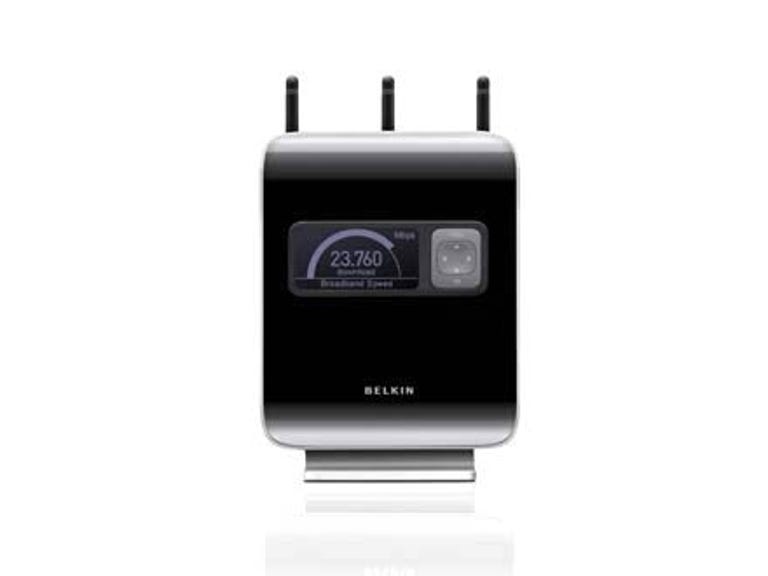 Why You Can Trust CNET
Why You Can Trust CNET Belkin N1 Vision Wireless Router review: Belkin N1 Vision Wireless Router
The N1 Vision Wireless Router brings some truly revolutionary ideas to home networking — and then proceeds to implement them in just about the sloppiest way possible.
Design
When it comes to basic router design, we've long held out that Belkin does it better than most. Not because their routers are abject things of beauty — that would be taking matters a little too far — but simply because they seem to understand that the average consumer doesn't necessarily want a box of blinkenlights but might want to know what's going on with their router every once in a while. Previous Belkin models have used a series of backlit icons to display system status; an idea at once simple and brilliant. The N1 Vision takes this idea and runs with it. Gone are the backlit icons, replaced instead with a monochrome LCD panel that not only displays system status, but also current data throughput, number of connected clients and the usage of the past 24 hours. It's even mildly configurable via the four way selector, menu and OK buttons located to the right of the display panel.
The Good
The Bad
The Bottom Line
Features
The N1 Vision is an 802.11n Draft 2.0 compatible router, which should bring it closer to some of the extravagant claims made about 802.11n than many other manufacturers. Note our careful use of the word "should" there — we'll get back to the Vision N1's performance shortly. It also comes with four gigabit ethernet ports for cabled connectivity. There's still no word on a version of the N1 with an ADSL2 modem built in, so you'll need an existing modem for internet connectivity.
Performance
While we love the idea of the N1 Vision and its glimpse into a future where simple networking might be actually achievable, the practical realities of the N1 Vision rather betray it. On a physical side, the buttons on the router's display face are rather fat and squishy. We're not making that as an aesthetic observation, but a functional one, as the pressure pads underneath feel tiny. As a result, actually getting the N1 to navigate the way you want to is an exercise in frustration, as all too often we'd make a selection, only to have the N1 sit there mutely doing nothing until we essentially hit it a little bit harder. Good for releasing stress, but not good for the router or its input panel.
Then there's the issue of whether or not 802.11n actually delivers on its networking promises. Those are promises in the range of 150-300Mbps, but we're yet to see a single N router come anywhere near that; most have tended to extend the range of wireless networking, which is great if you're in a structure that tends to retard wireless range, but have done little to actually improve data throughput. Bear in mind also that you'll need to pay for 802.11n adaptors to get the data benefit. Belkin provided us with a pair of N1 Wireless Notebook Cards for testing purposes, but you'll need to pay for them at an average price of around AU$120 each.
Sadly, the N1 did little to assuage our growing fears about 802.11n being a rather unattractive white elephant. Once again, range was improved with the N1, but throughput remained resolutely flat, and in some tests, even a little worse than we could get with dedicated 802.11g equipment. We could only intermittently get video of any definition to stream, and often with obvious stutters as the data struggled to fly through the air. Tests conducted in our US Labs against an array of routers backed up our suspicions; this isn't a router that's fast by any stretch of the imagination.
Our other major gripe with the N1 Vision was one of system stability. We're somewhat used to home routers not always being the most stable of networking products — essentially, if you want enterprise-level stability, you pay enterprise-level prices — but the N1 was, in our opinion, far too prone to lockups under its current firmware. The problem seems to be one of heat buildup; even though it's a vertically oriented router with lots of exposed (and thus more rapidly cooling) surface area, every time we found it had locked up, we'd also find the area around the power plug to be extremely hot. Hopefully this is something that can be fixed; as it stands the review model we were sent was unstable to the point of being non-functional.
Ultimately we left the N1 Vision feeling extremely frustrated. The promises of 802.11n are yet to be realised, and so are the promises of a truly user-friendly router. The N1 Vision is awfully close to fulfilling those promises — but nowhere near close enough to be worth buying.



